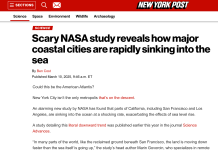A recent article in USA Today, titled “Atlantic Ocean current could collapse soon. How you may endure dramatic weather changes,” claims that a major ocean current system is likely to slow down and collapse as soon as 2025. This claim is based on computer model projections of the future based assumptions about past ocean current behavior and the factors which drive ocean currents. Actual data and its use is limited. The study’s conclusions are unsubstantiated by existing evidence and are contradicted by research which indicates that the Atlantic Ocean currents are likely speeding up.
The USA Today’s article is based on an article published in Nature which examines the Atlantic Meridional Overturning Circulation (AMOC), “a large system of ocean currents that carry warm water from the tropics into the North Atlantic.” The article and the study it references says the AMOC could collapse “by the middle of the century, or possibly any time from 2025 onward, because of human-caused climate change.” The research suggests that freshwater intrusion from Greenland meltwater will change the composition of the water and shut down the ocean conveyor system which moves hot and cold water around the Atlantic.
USA Today reports:
“Such a collapse could trigger rapid weather and climate changes in the U.S., Europe, and elsewhere. If it were to happen, it could bring about an ice age in Europe and sea-level rise in cities such as Boston and New York, as well as more potent storms and hurricanes along the East Coast.”
The study itself references a “slowing down” of the current, and assumes that a tipping point will be reached, and uses that assumption along with some statistical analysis to give a window of when that will supposedly happen. The study authors estimate that the AMOC will collapse sometime in the mid-century.
Incredibly, according to USA Today, the researchers claim they have a 95 percent certainty that the AMOC will collapse between 2025 and 2095.
USA Today’s article says studies from 2018 and 2021 agree such a collapse is possible.
The study’s claims are extraordinary, and thus, in the words of Carl Sagan, require extraordinary evidence before they are taken seriously. In the place of evidence, they provide complex statistical analyses.
Even the USA Today acknowledges that the study’s findings “contradict the message of the latest Intergovernmental Panel on Climate Change report, in which an abrupt change in the AMOC is considered “unlikely” this century.”
A widely reported 2020 study published in Science came to the exact opposite conclusion with its authors writing “[f]or nearly 25 years the currents have been rapidly speeding up, partly because of global warming.” Climate change can’t be both accelerating and decelerating the same ocean currents simultaneously.
The acceleration was described as equally alarming. The flip-flopping or contradictory views were covered by Climate Realism, here, here, and here, for example.
The difference between the studies that predict these polar opposite scenarios is that the recent studies that show acceleration have relied primarily on empirical evidence, such as this one by Oziel, et al. from 2021, and a confirming study that combines modeling and empirical data by Smedsrud et al. also in 2021, but the studies that show slowing seem to based their predictions almost exclusively numerical model outputs.
There is a place for modeling. If properly informed by accurate assumptions, they can be powerful tools, but when model outputs depart from observational or empirical data, model outputs should be questioned. Leaning heavily on climate models to paint an accurate picture of the future is questionable at best, as discussed many times by Climate Realism. Based on the available contradictory evidence, and the limited knowledge base, claiming with 95% certainty that such a collapse is imminent doesn’t ring as particularly scientific.
In regards to the real-world likelihood of such an event taking place, Eric Worrall analyzed these same claims and pointed out that a collapse of AMOC may have occurred in the past, abruptly leading to the Younger Dryas ice age conditions.
However, he explains that the Younger Dryas conditions are believed to have been caused by a sudden, massive, rapid freshwater intrusion, not the gradual melting of a major ice sheet.
Worrall writes:
The Younger Dryas collapse in Northern Hemisphere temperatures was believed to have been caused by disruption to ocean currents which occurred when a gigantic glacial lake sitting on the North American and Canadian ice sheet abruptly discharged thousands of cubic miles of water into the Atlantic Ocean, though there is evidence a lot of fresh water may have ended up in the Arctic Ocean.
Since no comparable freshwater glacial lake exists today, this can’t happen. If this theory of how the last AMOC collapse happened is true, it is unlikely that modern conditions can replicate the event.
Concerning data, the Nature study acknowledges:
The AMOC has only been monitored continuously since 2004 through combined measurements from moored instruments, induced electrical currents in submarine cables and satellite surface measurements. Over the period 2004–2012, a decline in the AMOC has been observed, but longer records are necessary to assess the significance.
In fact, based on the limited data, the authors have no way of knowing whether the AMOC speeds up and down cyclically on a multidecadal or multi-century basis, or whether a steady state is the norm.
Despite this fact authors of the study predict with “high confidence” that the “tipping” will happen between 2025-2095, but they also say that these results are “under the assumption that the model is approximately correct, and we, of course, cannot rule out that other mechanisms are at play, and thus, the uncertainty is larger.”
The authors also hedge their bets in the Discussion section of the Nature paper where they write “we can at present not rule out the possibility that a collapse will only be partial and not lead to a full collapse of the AMOC as suggested by some models.”
Despite these acknowledgements of limited knowledge and uncertainty, the authors insist that their statistical analysis represents “clear indicators of imminent collapse.”
USA Today and other media outlets should probably refrain from sounding the alarm so confidently about impending doom, when the authors of the study themselves go to great lengths within the document, if not in their title and abstract, to hedge their bets and acknowledge the numerous uncertainties in both the model outputs and their knowledge about the factors which enhance and diminish ocean currents.
As University of Pennsylvania climate researcher Michael Mann reportedly told USA Today regarding this study, “I’m not sure the authors bring much to the table other than a fancy statistical method. History is littered with flawed predictions based on fancy statistical methods; sometimes they’re too fancy for their own good.”

















Useful info.
Nice job Linnea, your writing skills excellent. Something I can read and understand from the get go. Us dyslexics have a hard time with the written word. we mortal tend to believe your side of the aisle rather than hype and hysteria from talking heads. Don’t abandon us Linnea. Dax
Nice job Linnea, your writing skills excellent. Something I can read and understand from the get go. Us dyslexics have a hard time with the written word. We mortals tend to believe your side of the aisle rather than hype and hysteria from talking heads. Don’t abandon us Linnea. Dax
There is another article in physics.org explaining the same rhetoric. I would like to know who funds physics.org because I am seeing a lot more articles with a lack of or misleading data